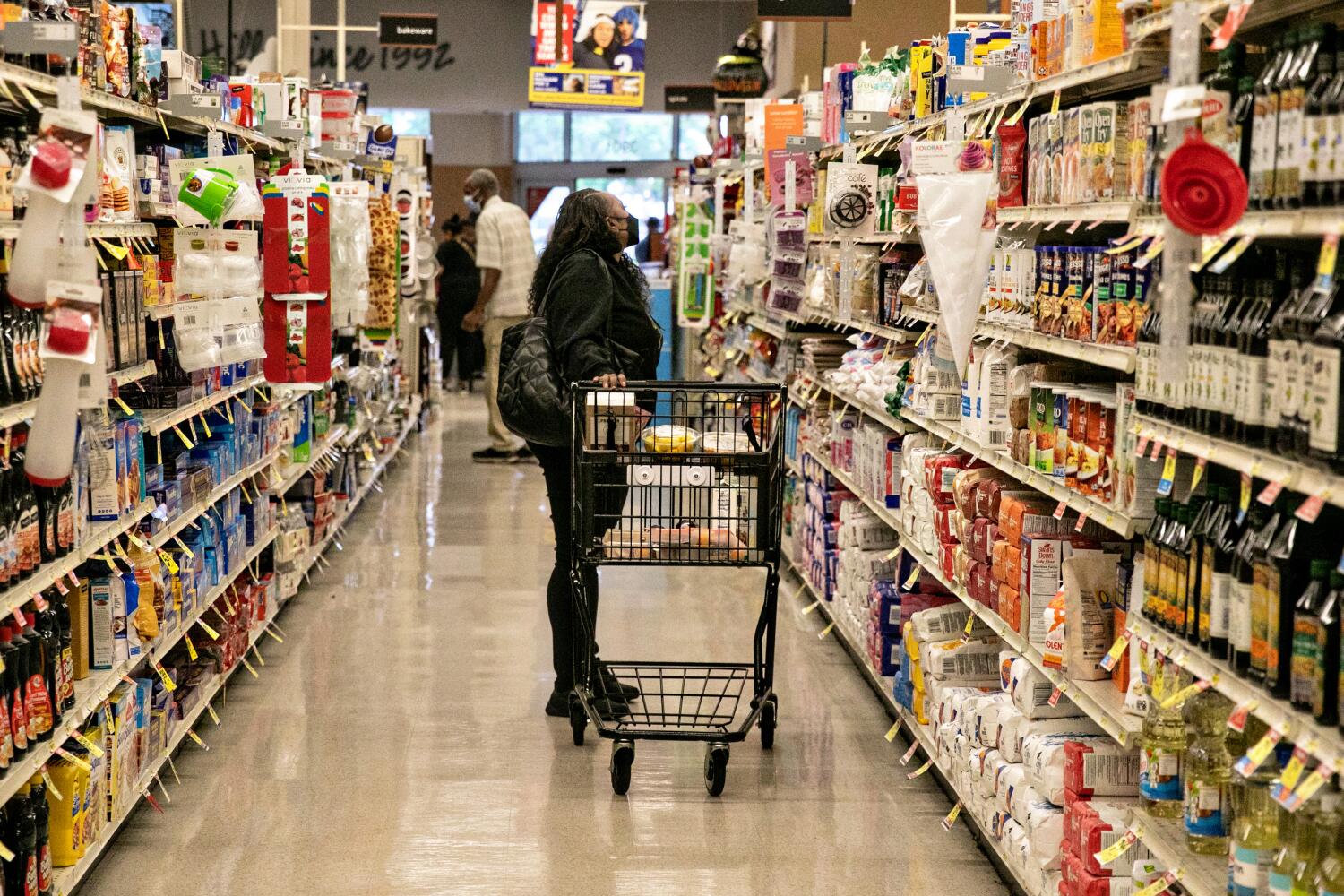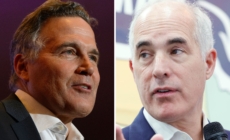-
The UK Faces a Dilemma: Cozy Up to Trump or Reconnect With Europe? - 13 mins ago
-
NYT ‘Connections’ November 22: Clues and Answers for Game #530 - 21 mins ago
-
Bob Casey Concedes to David McCormick in Pennsylvania Senate Race - 56 mins ago
-
Police in New Jersey’s Capital Violate Residents’ Rights, U.S. Finds - 57 mins ago
-
Steelers WR Van Jefferson Questionable to Return With Significant Leg Injury - 2 hours ago
-
Pam Bondi Is Trump’s New Choice as Attorney General. Here’s What to Know About Her. - 2 hours ago
-
Newsom touts his economic plans in California’s conservative regions - 2 hours ago
-
Trump Won’t Care that RFK Jr. Compared Him to Hitler, Ex-Aide Says - 2 hours ago
-
N.Y.C. Housing Plan Moves Forward With an Unexpected $5 Billion Boost - 2 hours ago
-
NFL Coach Who Got Fired Reveals Tricking Ian Rapoport Into Breaking False News - 3 hours ago
Would a Kroger-Albertsons merger drive prices up or down?

As grocery giants Kroger and Albertsons push to carry out the largest proposed supermarket merger in U.S. history, the companies’ executives have made a contentious claim.
Joining forces, they say, will push food prices down, not drive them up as U.S. regulators argue will happen if the deal is allowed to go through.
“The day that we merge is the day that we will begin lowering prices,” Kroger Chief Executive Rodney McMullen said in a federal court hearing this week.
Will shoppers, who have been frustrated in recent years by escalating grocery bills, finally see a cut in prices or not? Experts say the answer is complicated because food prices can vary by location and there are many forces at play.
The question of pricing has been a crucial part of an ongoing hearing a federal judge in Oregon is holding to decide whether to grant regulators’ request that she put a temporary halt to the merger. The high-stakes courtroom battle, which has featured testimony from grocery executives and antitrust experts, is expected to run through next week.
The Federal Trade Commission and several states’ attorneys general, including California Atty. Gen. Rob Bonta, say the deal would eliminate competition that helps lower prices. As rivals, Kroger and Albertsons compete with each other, so they have an incentive to keep prices down to attract customers, regulators say.
The companies have countered that together they would be big enough to compete with other behemoths that have staked increasingly large claims to the grocery market. A spokesperson for Kroger, which announced plans to purchase Albertsons in 2022 for $24.6 billion, said the merger would “bring lower prices to more customers,” allowing them “to better compete with massive retailers Walmart, Costco and Amazon.”
And in a presentation about the merger, the supermarket chain says over the years the company has reduced its gross profit margins to keep prices down. McMullen reiterated the claim in his testimony, noting that Albertsons’ prices are 10% to 12% higher than Kroger’s, so merging will help reduce the disparity.
The conflicting answers underscore the variety of factors that can influence whether shoppers are paying more for meat, eggs, vegetables and other popular food items, experts say. Rising food prices have become a political lightning rod in the U.S. presidential election with Vice President Kamala Harris — the Democratic presidential nominee — calling for a federal ban on “price gouging” as part of a plan to bring down grocery prices.
“In the grocery market, it’s really hard to tell what prices are going to be in two months because there are so many variables that go into grocery pricing,” said Donald Polden, a law professor and former dean at Santa Clara University. Weather conditions overseas, for example, might affect the ability to get certain products and that could impact the price.
The FTC alleges the merger would violate a federal antitrust law known as the Clayton Act that aims to fuel competition and prevent the formation of monopolies. When there’s less competition, there’s concern that a business can then charge whatever price they want, Polden said.
Americans are already feeling the pinch. Families are paying 25% more for groceries than they were before the pandemic, according to a February report by left-leaning think tank Groundwork Collaborative.
Californians are spending the most on groceries compared with other states. On average, California residents spent $297.72 on groceries every week, according to 2023 U.S. Census Household Pulse Survey data analyzed by HelpAdvisor. In Los Angeles, average weekly grocery spending was a few dollars lower but still above the national average.
John Mayo, a professor of economics, business and public policy at Georgetown University, said the costs of ingredients, worker wages, management efficiency and competition all play roles in determining food prices.
While “competition can be quite important in driving food prices at grocery stores,” he said, measuring exactly how big of a role it plays in a particular area is “sort of tricky.”
In its lawsuit challenging the merger, the FTC said people prefer to shop near where they live or work and so supermarket competition dynamics play out locally.
Grocery store mergers in major cities with a lot of competitors such as San Francisco, New York and Philidelphia have led to reduced prices. But in places with fewer competitors such as in Fort Smith, Ark., and Topeka, Kan., grocery store mergers have resulted in higher prices, Mayo said in a discussion about the topic.
Mayo referenced a 2012 study by the FTC Bureau of Economics that examined how prices changed after mergers in the grocery industry. The study looked at the relationship between prices and a measurement used to determine market competitiveness. Some of the mergers resulted in estimated price increases, others caused price decreases or had relatively little change in prices, economists found.
“There’s been very mixed evidence about whether mergers in the grocery store industry have a deleterious effect on pricing,” he said.
A 2023 report by the U.S. Government Accountability Office outlined other factors that can affect grocery prices such as animal and plant disease outbreaks, the Russia-Ukraine conflict, the COVID-19 pandemic and global trade issues.
The growing size of Albertsons and Kroger has caught the attention of regulators looking to protect consumers’ interests. Albertsons owns the well-known brands Pavilions, Safeway and Vons. Kroger operates Ralphs, Food4Less, Fred Meyer, Fry’s, Quality Food Centers and other popular grocery stores. If the merger goes through, the two supermarket chains would operate more than 5,000 stores in 48 states.
To fend off concerns that reduced competition will lead to higher grocery store prices, Kroger and Albertsons have proposed selling 579 stores to another company, C&S Wholesale Grocers. The proposal includes 63 stores in California, mainly in Southern California.
Prices aren’t the only concern regulators have. The antitrust lawsuit also cites potential effects on product quality, customer service, pharmacy services and union grocery labor.
For grocery store shoppers, though, prices are still at the top of their mind.
On a sweltering day in California, shoppers pushed their carts through an air-conditioned Safeway, weaving from aisles stocked with frozen foods, meat and vegetables.
Bright yellow signs throughout the San Leandro store displayed the latest deals for Safeway members. Buy one value pack of chicken wings and get the other pack for free, one sign read. The store on Washington Avenue is among those to be sold if the merger goes through.
San Leandro resident Alana Chand, 56, said she was taken aback when she saw cage-free eggs selling for around $8. Egg prices have been rising as a bird flu outbreak limits supply.
Still, she shops at Safeway because it’s close to where she lives. There’s also a Walmart in the city, but she doesn’t enjoy the shopping experience there because “it’s not the safest.”
“Price is a factor, but you end up getting what you need,” she said. “I mean, you just make it work”
Nationwide, Walmart is the most popular retailer, capturing 21% of consumer packaged goods spending, according to consumer data company Numerator. On the West Coast, Costco is the most popular retailer followed by Walmart, Albertsons, Kroger, Amazon and Target.
Oakland resident Ricardo Martinas, has noticed prices increasing in various retailers, including Costco, which raised membership fees for the first time in seven years. Spotting long lines and too many items locked up at Walmart, the 53-year-old opts to shop elsewhere. His wife, he said, really likes the quality of the organic vegetables and eggs at Safeway.
“She said they got better quality right here,” he said. “But for me, it looks the same. The price is a little bit higher, but she said she wants Safeway.”
With both government regulators and Kroger and Albertsons expected to appeal if they don’t win the court case, the wait for lower prices will probably not be over.
Source link




















